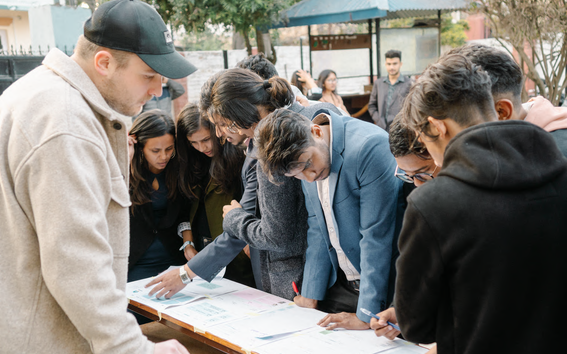Insights from studying collaborative MA programmes (Part 2/2)
After two years of studying my Master’s in Creative Sustainability (ARTS) and International Design Business Management as a minor subject, I feel the need to draw a short interim conclusion. In project-oriented and collaborative courses, I was, among others, on the road in South Africa and Nepal to solve wicked problems. Working with students from different disciplines and all kinds of stakeholders from the private sector and government agencies has given me many skills and insights that I would like to share with you.
I would like to summarise a few important observations about the two fields of study and their focus. Especially if you are interested in one of the two degree programmes or have already been accepted, these will hopefully facilitate the further course of your career.
This is the second part of this blog, so if you enjoyed reading it be sure to also consider the first half!
What did I learn about multidisciplinarity?
This point also relates to the previous question and is about the connection between the simplicity of project management and the level of agreement that exists in the team in terms of priorities and the most important values. For example, teamwork can be difficult if not every team member is clear about the value and benefits of Design Thinking. Any attempt of intensive collaboration can be undermined by the will to work alone and the opinion that everyone takes on a part of the project that they are good at anyway and at the end of the project everything simply has to be put together by everyone. The attempt to incorporate research methods of design thinking can also be sabotaged by this unwillingness resulting from false values. Many of these methods rely on in-depth and accurate processing and simply do not work if the value is not recognised.
Related to this is the observation of how challenging it is to break traditional roles of professional disciplines. Especially under time pressure and in a project with great uncertainties about the course and the result. When it comes down to it, the designer does the design and the business student the business model canvas. This has both positive and negative consequences. On the one hand, the efficiency and speed of this approach are positive. This is especially helpful in short projects where time is a scarce resource. It is also easier for the team to justify itself externally when stakeholders know that people with the respective profession and their expertise are the main contributors to certain parts of the project. On the other hand, the low learning potential outside one's own comfort zone and area of expertise is a negative factor. This mutual learning, however, should be one of the focal points of multidisciplinary work. As discussed above, this often results in a lack of mutual understanding and empathy. A negative example here is another team from Aalto Global Impact, whose internal problems I have heard about: The importance of an appropriate design of their project report by the designer was not valued in the group and he was therefore attacked for taking too long. It is essential to constantly educate about the value of one's own methods and thereby build understanding, which brings me to the next topic, communication.
What did I learn about communicating?
The importance of precise yet easily understandable language - especially in multidisciplinary teams. I can quickly be misunderstood or have lengthy discussions with other team members, only to realise in the end that we mean the same thing. This is usually due to one of three things: First, because I wrongly assume knowledge about my methods or expertise and their terminology from others. Secondly, that I express my thoughts in too complicated a way, where often simple descriptions, metaphors or anecdotal explanations would suffice. This problem is particularly prevalent when communicating with stakeholders such as community members or other beneficiaries who may have had a different educational background than me. Thirdly, it is often a careless choice of words, which is also affected by my use of technical words in English as a foreign language.
What did I learn about bringing the learnings of my Master’s program into practice?
I have to say that especially in the larger projects, I am always surprised by the lively interest that this way of thinking and approaching projects has met with. Before the actual fieldwork, I often assumed the opposite. Especially in other disciplines and in other countries like South Africa or Nepal, where Design Thinking, Systems Thinking and other of our concepts are still completely new territory, the people involved were very interested in our way of problem solving. And some of them indicated that they would try to read up more and integrate these methods more into their field of expertise or profession. This feedback makes me really optimistic about the impact of our work in this world, big and small.
If these observations resonate with you or if you have any further questions about the courses or the courses themselves, please feel free to look for me on Unibuddy and write to me there!
- Michael, second year master's student at Aalto University School of Arts, Design and Architecture

Show other posts from this blog

My First Experience Living in a Student Apartment in Finland
Valerie shares her experiences vs. reality with student apartments and gives tips on how to get one!
How to Furnish your Student Apartment Low Budget
Francesco gives tips on where and how to find furniture with a budget in Finland for your new unfurnished apartment.
Join the board of a student organization!
Ioanna tells what it's like to be a board member of a student organisation at Aalto and gives examples of her own experiences.